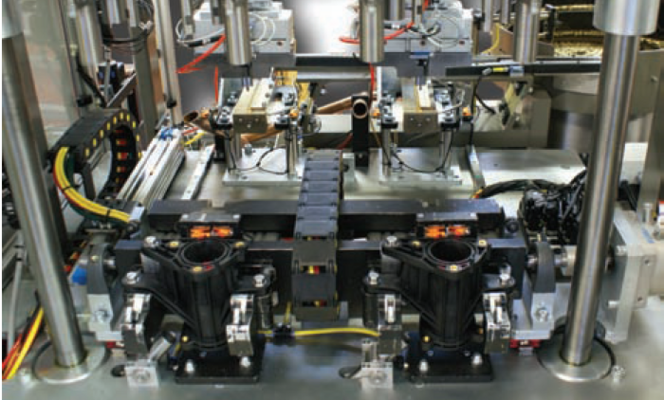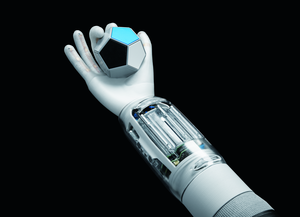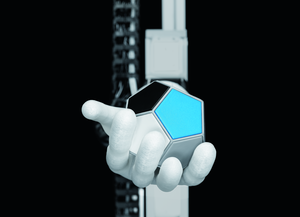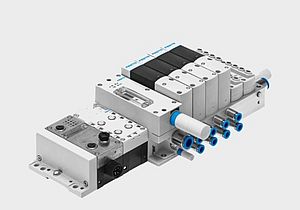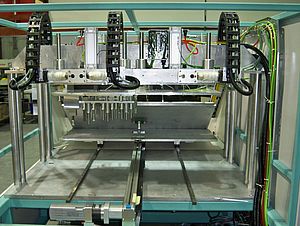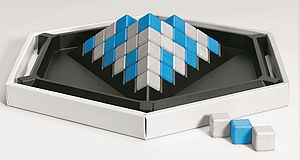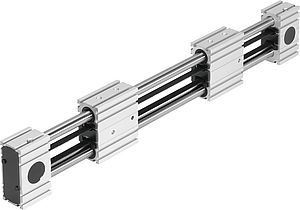TQC, the specialist automation company, has developed an innovative machine for pressing pre-formed metal inserts into the body of a plastic throttle body adaptor moulding. The machine fully automates the entire insertion process - including checking insert depth -and uses closed-loop position and torque servo-control techniques to ensure consistent accuracy and quality. A novel dual-channelmachine architecture enables two throttlemouldings to be processed simultaneously, in order to secure a throughput of one moulding every 35 seconds.
The insertion machine was produced specifically for Mahle Filter Systems, a leading automotive components manufacturers. It handles cold insertion of three steel compression limiters and hot insertion of six threaded brass inserts, in each of the two throttle body mouldings. According to TQC’s Sales Engineer Mike Gordon, “We were up against considerable competition from companies in Asia for this particular machine contract. But whereas our competitors proposed using individual, physically separate insertion mechanisms for each phase of the process, we developed an innovative four-axis servo-controlled manipulator that enables all twelve hot insertion operations to be performed two at a time, consecutively into a pair of static throttle body mouldings. This approach provides several key competitive advantages - it limits the amount of work-piece movement that is needed and thereby helps to minimise machine process time, and has enabled us to create a very compact machine that takes up little space on the factory floor.”
The machine is a freestanding unit designed for fully autonomous operation, and makes extensive use of Festo electric and pneumatic automation technology. Overall control is managed by a built-in Mitsubishi PLC, which uses Profibus-DP to communicate with the various servo controllers and drives, with all operator commands and feedback being handled by a front panel colour touch screen Mitsubishi GOT HMI. The machine is EN 954-1 safety compliant, and employs comprehensive light guarding and auto shutdown procedures to protect the operator from any inadvertent exposure to moving parts.
The machine operator manually loads components into fixtures at the front of the machine, and then initiates the insertion process. Extensive poka-yoke sensing of component features ensures that the operator is immediately alerted to any missing or misoriented components. Provided that all parts are present and correct, the machine cycle commences. Firstly, a twin-headed press system pushes home three steel compression limiters perpart and verifies their presence and correct position. The fixture is then automatically retracted into thehot insertion station along a pair of linear guides. The threaded inserts are fed from an Alphamation twin-track vibratory bowl feeder to two temperature controlled heater blocks, where they are heated to approximately 350 degrees Celsius and queued ready for use. Hot inserts are transferred from the heater blocks to the throttle mouldings a pair at a time byan overhead twin Z-axes pick and place system, utilising DGE actuators for X-Y positioning. Gripper fingers are driven by HGPP pneumatic precision parallel grippers, incorporating electric sensors for position feedback.
The vertical Z-axis movement of the gripper fingers is controlled by a servomotor-driven DNCE electric cylinder and CMMP motor controller combination. The motor controllers employ a combination of torque and position control modes, enabling the downward speed and forceof the gripper fingers to be varied very accurately to accommodate themelt rate of the plastic, as the heated insert is pressed into the throttle moulding. Each throttle moulding has three inserts successively pressed into its top face, and then the support fixture is rotated through 180 degrees by a pneumatically-powered DSM-B swivel module, so that a further three inserts can be pressed into the moulding’s bottom face.
Once all the brass inserts have been pressed into the throttle mouldings they are automatically checked for correct insertion depth, with a tolerance of flush to 0.2 mm proud maximum, and the fixture is then returned to the operator to manually fit a seal to each moulding. The machine verifies the position of the seals, and providing that everything is correct, places a ‘pass’ stamp on each completed throttle assembly.
All design and development of the insertion machine was carried outby TQC, although as Mike Gordon points out, “Festo provided us with valuable support, including help with some of the insertion force algorithms and the provision of CAD models of the linear and rotary actuators for our initial design work. We use SolidWorks 3D for all mechanical design work - we operate eight CAD work stations at our Nottingham facility - so obtaining the CAD models of key components early in the design phase gave us a great head start. Also, subsequent to the machine being installed, Mahle decided to use slightly smaller inserts, which meant that we had to re-tool the machine. The net result is avery happy and highly productive customer!”


